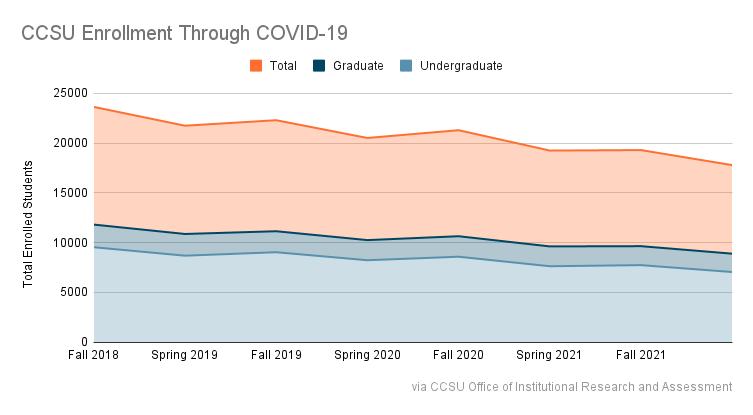CCSU Sees Lowest Enrollment Numbers in Recorded History
CCSU enrollment through COVID-19.
May 4, 2022
Historically, Central Connecticut State enrollment has hovered at around 12,000 students, but after the COVID-19 pandemic, that number has dramatically dropped by 25%, according to the university’s research.
Since 1975, CCSU’s enrollment had never dropped below 11,400 until this semester, when there are only 8,898 students enrolled, according to its Semi-Annual Statistical Report.
Even before the pandemic, enrollment was declining, according to historic enrollment data from the university’s Office of Institutional Research and Assessment. Between 2000 and 2018, fall enrollment averaged 12,186 students. Before the pandemic in the fall of 2019, that number was only 11,154 students. All of the figures include graduate students as well as undergraduates.
The 8,898 students enrolled at CCSU now are a fifth less than 2019’s students and over a third less than the 2000-2018 average.
CCSU President Zulma Toro addressed the steep drop in enrollment at her open forum on Thursday and discussed what the university is doing to reverse the decline.
“We have established what we like to call the support blanket,” she said.
That blanket consists of establishing a new First-Year Program to help restore the retention of first-time, first-year students and bolstering existing programs like financial aid, advising, counseling services, and residence hall living and learning communities.
But Toro acknowledged that the enrollment drop hurts the university.
“The fact is that enrollment decline is costly for us… It’s costly,” she said. “For every 500 full-time students that we lose, we are losing close to $7 million [in revenue].”
According to its historical spending plan document, CCSU has already budgeted for higher expenses than revenues in 2022. The university has predicted spending $5,501,789 more than the $233,317,904 it expects to bring in. In 2019, CCSU made over $10 million more in revenue.
According to past actual revenues, the decreased revenue comes entirely from the loss of 10% of the university’s income from tuition and fees since 2019.
Toro said the university lost $30 million in revenue from tuition and fees for 2022. Still, information obtained from CCSU officials through a Freedom of Information request shows that $21 million in federal CARES Act funds helped offset losses in revenue from tuition, room, board, fees, events and other auxiliary services.
CCSU is predicting a $16.6 million increase in expenditures this year, and Toro maintained that the university is financially stable.
“This year and next year, we seem to be in good financial footing,” she said. “But what is important for me is to have long-term financial sustainability for the university.”
The university has set goals for recruiting students back to campus, and Chief Operations Officer Sal Cintorino said that one of the university’s top goals is to bring students back to residence halls.
According to CCSU’s semi-annual report, since 2019, CCSU has housed 552 fewer students, a loss of over a quarter of the 2,179 residents on campus in the fall of 2019.
“We’re trying to get back up to 2,000 in the [residence] halls,” he said. “If we only bring in four or 500 students, we’ll have financial problems.”
Cintorino said that the university is working to provide programs to help students who need extra support due to the pandemic and make coming back to CCSU more accessible.
“We’ve recognized how important it is,” he said. “Right now, we are working diligently with recruitment and retention.”
Ariel Wolfe, a former CCSU student who left during the pandemic, said that there wasn’t anything CCSU could’ve done differently to have made her stay.
“Being at home for so long made me think about what I really wanted to do with my future and career path,” she said.
Wolfe left CCSU to pursue a full-time job as a bartender. She said she had fallen in love with the work while attending school online and knew she would be happier after deciding to do it as a career.
“I’ve been making enough money to sustain myself and more,” she said. “It was a hard choice to drop out, but I think it was the best decision.”
Public colleges and universities across the state have seen similar enrollment declines. In the last five years, enrollment has dropped by 22% in the Connecticut State Colleges and Universities system, including all four regional state universities and the community colleges.
At CCSU, the enrollment decline varies at each university’s schools and colleges. According to OIRA data, from Fall of 2018 to Spring of 2022, the School of Education and Professional Studies’ enrollment dropped the least, only by 19%. The School of Liberal Arts and Social Sciences decreased by 26%, and the School of Business decreased by 33%. The School of Engineering, Science and Technology’s enrollment fell by 21%. Enrollment of students committed to no school or inter-school programs plummeted by 43%, losing almost half of those students.
The number of faculty members at CCSU has also dropped after the pandemic, but not enough to match the drop-in students. According to OIRA, in 2018, there were 977 full and part-time faculty members employed, and in 2022, there are only 828. This makes for a 15% drop in faculty members compared to the 25% drop in students.
This has boosted the student-to-faculty ratio from 15:1 to 14:1.



